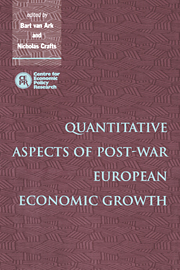Book contents
- Frontmatter
- Contents
- List of figures
- List of tables
- List of contributors
- Preface
- 1 Catch-up, convergence and the sources of post-war European growth: introduction and overview
- 2 Macroeconomic accounts for European countries
- 3 Sectoral growth accounting and structural change in post-war Europe
- 4 Measures of fixed capital stocks in the post-war period: a five-country study
- 5 Technology indicators and economic growth in the European area: some empirical evidence
- 6 Human capital and productivity in manufacturing during the twentieth century: Britain, Germany and the United States
- 7 Convergence and divergence in the European periphery: productivity in Eastern and Southern Europe in retrospect
- 8 Convergence: what the historical record shows
- 9 Growth and convergence in OECD countries: a closer look
- 10 On the historical continuity of the process of economic growth
- 11 Europe's Golden Age: an econometric investigation of changing trend rates of growth
- Index
3 - Sectoral growth accounting and structural change in post-war Europe
Published online by Cambridge University Press: 23 December 2009
- Frontmatter
- Contents
- List of figures
- List of tables
- List of contributors
- Preface
- 1 Catch-up, convergence and the sources of post-war European growth: introduction and overview
- 2 Macroeconomic accounts for European countries
- 3 Sectoral growth accounting and structural change in post-war Europe
- 4 Measures of fixed capital stocks in the post-war period: a five-country study
- 5 Technology indicators and economic growth in the European area: some empirical evidence
- 6 Human capital and productivity in manufacturing during the twentieth century: Britain, Germany and the United States
- 7 Convergence and divergence in the European periphery: productivity in Eastern and Southern Europe in retrospect
- 8 Convergence: what the historical record shows
- 9 Growth and convergence in OECD countries: a closer look
- 10 On the historical continuity of the process of economic growth
- 11 Europe's Golden Age: an econometric investigation of changing trend rates of growth
- Index
Summary
Introduction
The role of sectoral performance in economic growth has been a topic of major importance in growth studies from Adam Smith and David Ricardo onwards. Some scholars claimed that the shift of employment from low productivity to high productivity sectors was one of the main factors behind the overall rise in productivity. For example, ‘structural change’ was seen by Kuznets (1966) as one of the major ‘stylized facts’ of growth, although in his view it was more encompassing than only changes in sectoral shares of employment and output. Chenery et al, (1986) defined structural transformation as ‘the set of changes in the composition of demand, trade, production, and factor use that takes place as per capita income increases’ (pp. 31–2).
An alleged need for structural change is also mentioned frequently as a motive behind the promotion of European economic integration. According to its supporters, liberalization of trade relations and greater mobility of factor resources between member countries of the European Union is assumed to enhance structural change, with a positive effect on the growth of GDP and productivity.
To provide empirical evidence of the effect of sectoral change on economic growth during the post-war period, this chapter analyses estimates of empirical evidence on growth and levels of output and productivity by sector of the economy.
- Type
- Chapter
- Information
- Quantitative Aspects of Post-War European Economic Growth , pp. 84 - 164Publisher: Cambridge University PressPrint publication year: 1997
- 36
- Cited by



